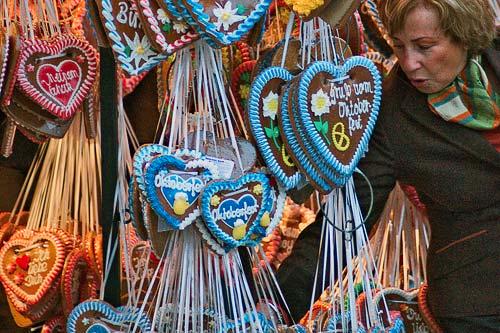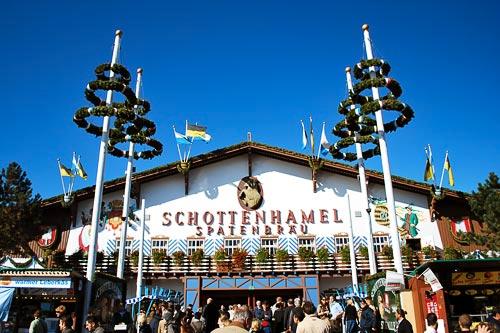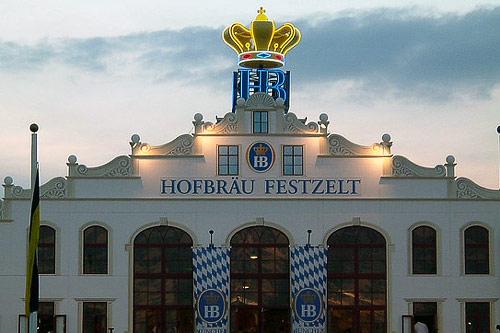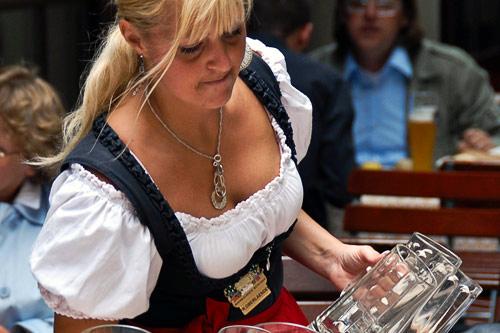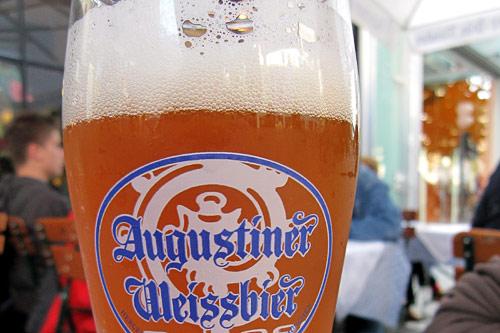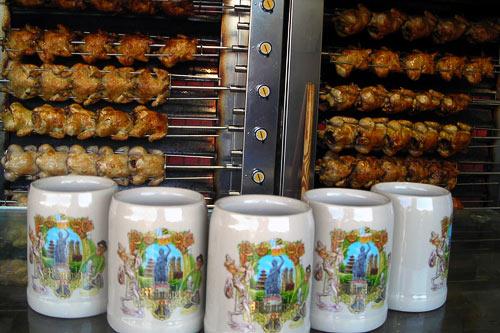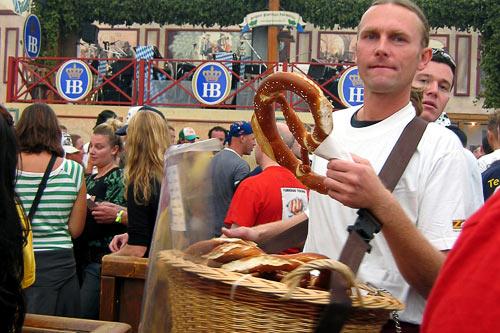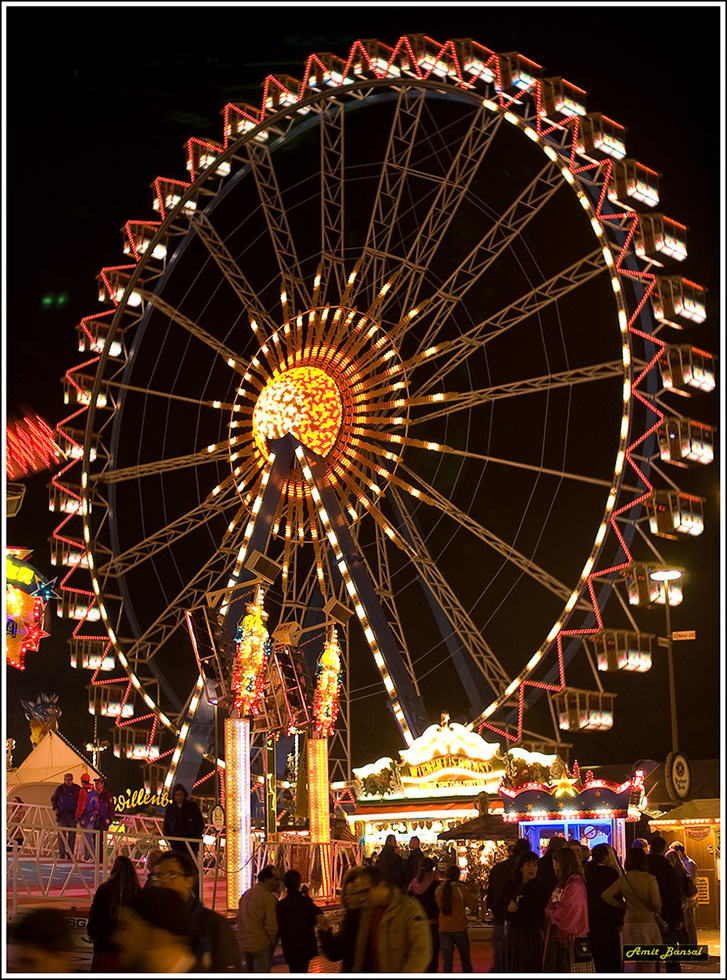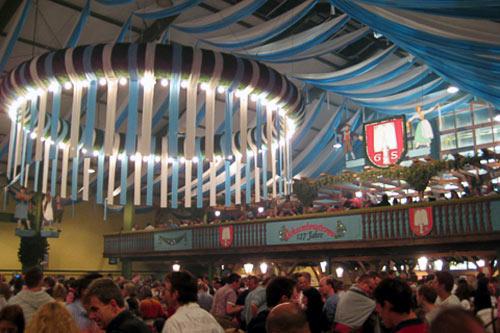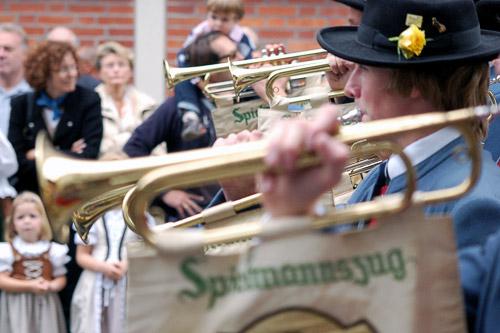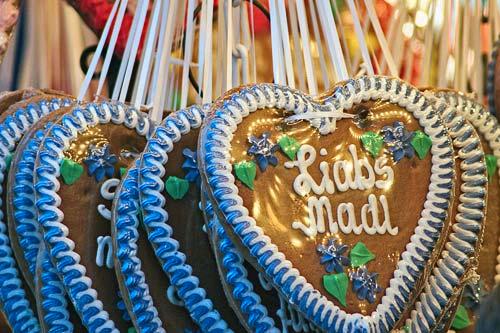10 Oktoberfest Traditions
By Laura Kiniry
Believe it or not, there's much more to Oktoberfest than beer. From chicken dances and sing-alongs to giant pretzels and gingerbread necklaces, these traditions at Munich's favorite fall festival go beyond the brew—though there's plenty of that, too.
Oktoberfest traditionally starts on a Saturday in late September and continues for 16–18 days.
Photo Caption: Strings of lebkuchen (gingerbread necklaces) make perfect souvenirs. Photo by springm / Markus Spring
Oktoberfest traditionally starts on a Saturday in late September and continues for 16–18 days.
Photo Caption: Strings of lebkuchen (gingerbread necklaces) make perfect souvenirs. Photo by springm / Markus Spring
The Festival Kick-Off
The official festival kick-off takes place at noon inside the oldest beer tent, Schottenhamel, when Munich's mayor taps the first keg and exclaims, O'zapft is! or, it is tapped! This signals the beginning of draught pouring throughout the fair.
The following day, crowds gather for the 10 a.m. Costume and Riflemen's Parade, a five-mile procession of more than 7,000 costumed dancers, marching bands, animals, and floats through Munich's city center.
Schottenhamel is the oldest beer tent at Oktoberfest. Photo by AbhijeetRane/Flickr.com
The following day, crowds gather for the 10 a.m. Costume and Riflemen's Parade, a five-mile procession of more than 7,000 costumed dancers, marching bands, animals, and floats through Munich's city center.
Schottenhamel is the oldest beer tent at Oktoberfest. Photo by AbhijeetRane/Flickr.com
The Beer Tents
Oktoberfest may be the world's largest folk festival, but its biggest draw remains the free-to-enter beer tents. Fourteen temporary structures range in size from the massive Hofbräu Festzelt -- a favorite among Americans for its revelry and oom-pah bands -- to the 2,900-seat Käfers Wiesen Schänke, known for its selection of gourmet cuisine and celebrity attendees.
Most tents feature food and music, and are packed with picnic tables and benches that fill up quickly. While parties of two to three can usually squeeze in beside a group that's already seated, those of 6 or more should reserve a table in advance or visit one of the smaller, less crowded tents. The Augustiner -- a tent known for its family atmosphere and traditional tunes -- is a local favorite.
Photo Caption: Hofbräu Festzelt is another popular Oktoberfest beer tent. Photo by das kine/Flickr.com
Most tents feature food and music, and are packed with picnic tables and benches that fill up quickly. While parties of two to three can usually squeeze in beside a group that's already seated, those of 6 or more should reserve a table in advance or visit one of the smaller, less crowded tents. The Augustiner -- a tent known for its family atmosphere and traditional tunes -- is a local favorite.
Photo Caption: Hofbräu Festzelt is another popular Oktoberfest beer tent. Photo by das kine/Flickr.com
The Outfits
Donning traditional Bavarian garb is a great way to feel part of the Oktoberfest festivities. Men wear lederhosen (a pair of shorts or three-quarter-length pants sporting either buttoned or zippered fastening), a drop-front flap, and leather suspenders with a front cross strap. Many pairs come embroidered. Add a white shirt, long socks and boots, and top off the outfit with a Trachten hat, or German-style hiking hat, adorned with a tuft of goat hair.
For women the dress du jour is the dirndl -- a flattering ensemble of a bodice, a blouse, and a full-skirt with apron. Where you tie your bow signifies your relationship status: left means single; right means taken. Oktoberfest-style clothing is sold at both new and used clothing stores throughout Munich, and is also available at city rental shops.
Photo Caption: Traditional Bavarian garb for women includes the dirndl. Photo by Konstantyn
For women the dress du jour is the dirndl -- a flattering ensemble of a bodice, a blouse, and a full-skirt with apron. Where you tie your bow signifies your relationship status: left means single; right means taken. Oktoberfest-style clothing is sold at both new and used clothing stores throughout Munich, and is also available at city rental shops.
Photo Caption: Traditional Bavarian garb for women includes the dirndl. Photo by Konstantyn
The Beer
All beers at Oktoberfest come from six Munich breweries -- Hacker Pschorr, Hofbräu, Paulaner, Spaten, Lowenbrau, and Augustiner -- and are traditionally served in one-liter krugs (steins). One exception is Weissbier (wheat beer), which typically comes in tall, fluted half-liter glasses. Expect to pay about $11 cash for one mas (liter) of beer -- a reasonable price for the quantity you receive.
When toasting, make eye contact with your drinking compatriot and raise and clink your glasses together, shouting Prost! (Cheers!), before taking a swig. With a wheat beer, remember to toast with your glass at the bottom -- its thickest portion -- to prevent shattering.
Photo Caption: Weissbier (wheat beer) is typically served in half-liter glass flutes instead of one-liter steins. Photo by Accidental Hedonist/Flickr.com
When toasting, make eye contact with your drinking compatriot and raise and clink your glasses together, shouting Prost! (Cheers!), before taking a swig. With a wheat beer, remember to toast with your glass at the bottom -- its thickest portion -- to prevent shattering.
Photo Caption: Weissbier (wheat beer) is typically served in half-liter glass flutes instead of one-liter steins. Photo by Accidental Hedonist/Flickr.com
Quintessential Bavarian Food
Hearty Bavarian dishes are an Oktoberfest staple, and sampling them is a good way to pace your beer intake. Visit the Armbrustschützenzelt tent to try local delicacies like Hendl (a half or whole spit-roasted chicken) and Haxn (pork knuckles). The smaller Fischer Vroni tent offers a large fish selection, including festival favorite Steckerlfisch (grilled whitefish on a stick).
Variations of these dishes, along with Würstl (sausages), Knoedel (dumplings), and Brotzeit (snacks consisting of meats, cheeses radishes, and bread) are readily available throughout festival grounds.
Photo Caption: Racks of hendl (spit-roasted chicken) are must-have festival foods that pair nicely with beer brews. Photo by NiceBastard/Flickr.com
Variations of these dishes, along with Würstl (sausages), Knoedel (dumplings), and Brotzeit (snacks consisting of meats, cheeses radishes, and bread) are readily available throughout festival grounds.
Photo Caption: Racks of hendl (spit-roasted chicken) are must-have festival foods that pair nicely with beer brews. Photo by NiceBastard/Flickr.com
Classic Bavarian Snacks & Desserts
One of Oktoberfest's most beloved side-dishes is the Brezel (soft pretzel). Festival versions are gigantic, doughy, sprinkled with salt, and best purchased from vendors stationed outside the side and front entrances of each beer tent.
For something sweet, stop by a food stand and ask for Gebrannte Mandeln, sugar-glazed almonds cooked in copper kettles and served in paper cones.
Photo Caption: A vendor sells brezel (a giant soft pretzel) by the basket. Photo by Ann Teng/Flickr.com
For something sweet, stop by a food stand and ask for Gebrannte Mandeln, sugar-glazed almonds cooked in copper kettles and served in paper cones.
Photo Caption: A vendor sells brezel (a giant soft pretzel) by the basket. Photo by Ann Teng/Flickr.com
Photo by ZeHawk/Flickr.com
The Fun Fair
Since the late 19th century, a Fun Fair has been an integral part of the overall celebration. Along with thrill rides such as roller coasters, log flumes, and a 164-foot-tall Ferris Wheel (Risenrad), the fair hosts a flea circus, street performers, and bands.
There's also a Budenstrassa, or Avenue of Booths, popular for its food stalls, souvenir stands, and games of chance. Tuesdays during Oktoberfest are family day at the fun fair, with day-long discounts on rides and performances.
Photo Caption: The 164-foot-tall Ferris Wheel is just one part of the Fun Fair. Photo by ZeHawk/Flickr.com
There's also a Budenstrassa, or Avenue of Booths, popular for its food stalls, souvenir stands, and games of chance. Tuesdays during Oktoberfest are family day at the fun fair, with day-long discounts on rides and performances.
Photo Caption: The 164-foot-tall Ferris Wheel is just one part of the Fun Fair. Photo by ZeHawk/Flickr.com
The Chicken Dance
No Oktoberfest is complete without the Chicken Dance, a festival tradition for more than two decades. Set to an oom-pah song of the same name, Der Ententanz ("Dance Little Bird," or simply put, "The Chicken Dance") is one of the few reasons to put down your beer.
To participate, make chicken beaks with your hands by pressing together your thumbs and fingers, opening and closing them like mouths four times to the music. Next, tuck your hands into your armpits and flap elbows four times outward. Then, lower your hands to your sides with palms downward and fingers outstretched, bend your knees, and wiggle back and forth four times. Finally, rise to your feet while clapping four times, and either spin in circles with your arms outstretched, or lock arms with your neighbor and spin. Repeat faster each verse, keeping in time to the music.
Photo Caption: Spaten beer tent is festooned for Oktoberfest celebrations. Photo by Carnesaurus/Flickr.com
To participate, make chicken beaks with your hands by pressing together your thumbs and fingers, opening and closing them like mouths four times to the music. Next, tuck your hands into your armpits and flap elbows four times outward. Then, lower your hands to your sides with palms downward and fingers outstretched, bend your knees, and wiggle back and forth four times. Finally, rise to your feet while clapping four times, and either spin in circles with your arms outstretched, or lock arms with your neighbor and spin. Repeat faster each verse, keeping in time to the music.
Photo Caption: Spaten beer tent is festooned for Oktoberfest celebrations. Photo by Carnesaurus/Flickr.com
The Music
From yodeling to brass bands, music is essential to any Oktoberfest celebration, and beer tent sing-alongs are a festival highlight.
Popular drinking songs include the repetitive "Ein Prosit," John Denver's "Country Roads," and "Aserejé." Also known as "The Ketchup Song, "Aserejé" tells a story in Spanish that centers on the Sugarhill Gang's 1970 rap hit, "Rapper's Delight." Its fast-paced refrain is a misinterpretation of the song's actual lyrics:
Aserejé ja de jé de jebe (I said a hip hop, the hippie, the hippie)
tu de jebere sebiunouva (do the hip hip hop, a you don't stop)
majabi an de bugui (the rockin' to the bang bang boogie say up jumped the boogie)
an de buididipí (to the rhythm of the boogie, the beat)
Another fun sing-along is the sway-worthy "Sierra Madre." Its chorus is easy: Sierra, Sierra Madre del Sur; Sierra, Sierra, Madre.
Photo Caption: Brass bands are another festive Oktoberfest highlight. Photo by hekris/Flickr.com
Popular drinking songs include the repetitive "Ein Prosit," John Denver's "Country Roads," and "Aserejé." Also known as "The Ketchup Song, "Aserejé" tells a story in Spanish that centers on the Sugarhill Gang's 1970 rap hit, "Rapper's Delight." Its fast-paced refrain is a misinterpretation of the song's actual lyrics:
Aserejé ja de jé de jebe (I said a hip hop, the hippie, the hippie)
tu de jebere sebiunouva (do the hip hip hop, a you don't stop)
majabi an de bugui (the rockin' to the bang bang boogie say up jumped the boogie)
an de buididipí (to the rhythm of the boogie, the beat)
Another fun sing-along is the sway-worthy "Sierra Madre." Its chorus is easy: Sierra, Sierra Madre del Sur; Sierra, Sierra, Madre.
Photo Caption: Brass bands are another festive Oktoberfest highlight. Photo by hekris/Flickr.com
The Souvenirs
When Oktoberfest ends, it is tradition to take a tangible memory with you. Fines are steep for stealing one of the heavy glass krugs in which beer is served, but they are available for purchase at each tent's souvenir shop.
Festival organizers also release a commemorative Oktoberfest stein that is for sale throughout festival grounds. The ceramic mug comes with a pewter lid (about $70) or without (about $50) and features the official logo for that year.
Another favorite and easy-to-find souvenir is the Lebkuchen (gingerbread necklace). These gingerbread hearts are decorated with German phrases such as Ich Liebe Dich (I love you) and come strung with a ribbon for wearing home.
Photo Caption: A lebkuchen (gingerbread heart-shape necklace) is a sweet Oktoberfest souvenir. Photo by springm / Markus Spring
Festival organizers also release a commemorative Oktoberfest stein that is for sale throughout festival grounds. The ceramic mug comes with a pewter lid (about $70) or without (about $50) and features the official logo for that year.
Another favorite and easy-to-find souvenir is the Lebkuchen (gingerbread necklace). These gingerbread hearts are decorated with German phrases such as Ich Liebe Dich (I love you) and come strung with a ribbon for wearing home.
Photo Caption: A lebkuchen (gingerbread heart-shape necklace) is a sweet Oktoberfest souvenir. Photo by springm / Markus Spring





